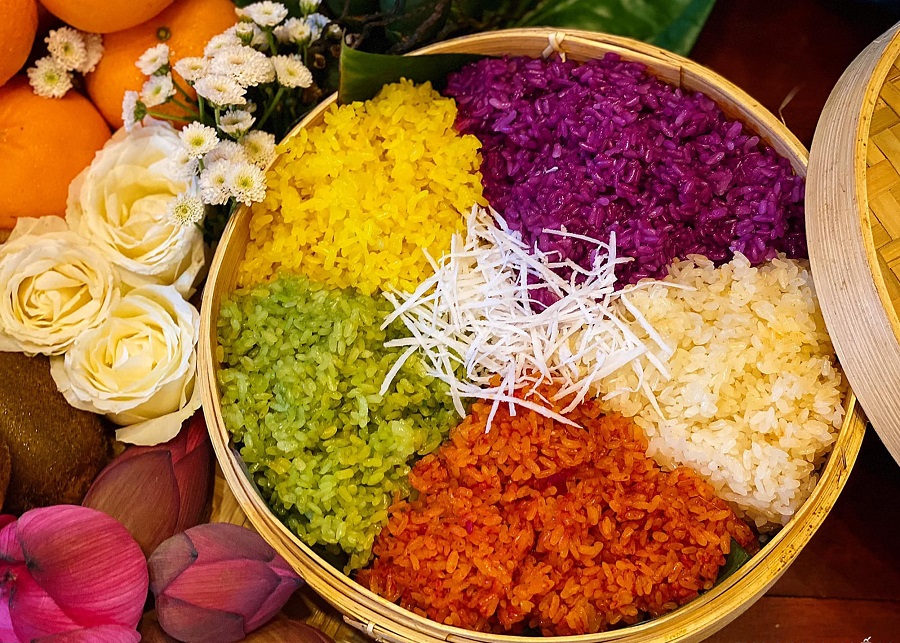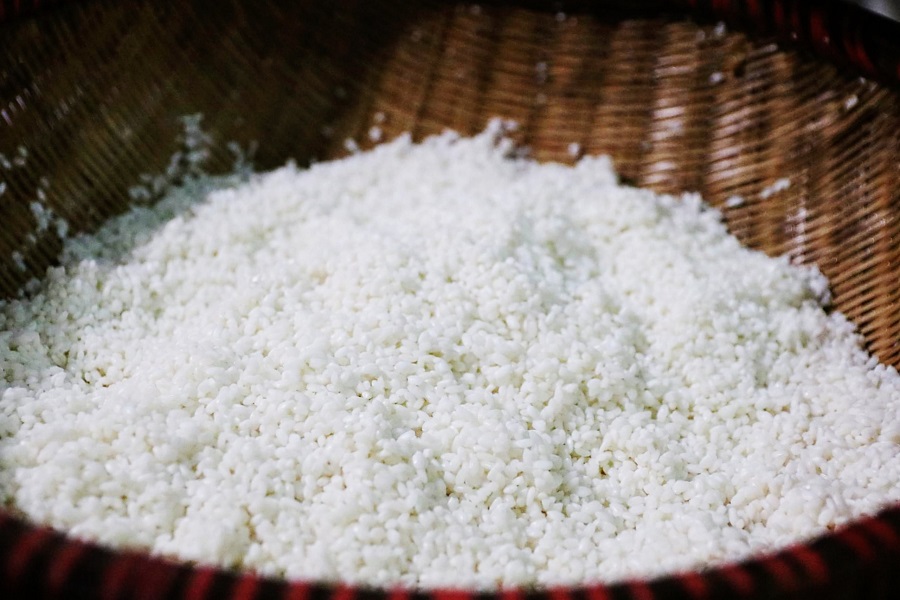Phu Thuong’s soft and fragrant steamed sticky rice
A local artisan keeps the family secret of making a Hanoi’s specialty, the Phu Thuong steamed sticky rice.
It remains unknown when the people of Phu Thuong Ward in Hanoi's Tay Ho District started making Xoi, or steamed sticky rice, but ever since she was a child, Nguyen Thi Tuyen saw her mother and grandmother working hard day and night to prepare Xoi to sell on the street.
| The wonderful dish of Xoi ngu sac or Five-color Xoi is prepared from white sticky rice mixed with colorful natural ingredients. Photo: Thanh Hen |
Outside of school hours, Tuyen also helped her mother and grandmother rinse rice, beans, and leaves for wrapping.
“It is because my mom and granny taught me even the most simple steps since I was a child, that I soon mastered the traditional trade and developed the passion to follow and maintain it to this day,” she recalled her childhood.
Born to be a Xoi maker
Everyone practices a trade when they grow up, and Tuyen chose to pursue the traditional trade of her village and family. She said the choice was not because she had no better options, but because she is by nature a purely agricultural woman, always oriented towards rustic, traditional values.
She believes that any trade is a trade, and with hard work, even Xoi makers can earn stable incomes, while also preserving the tradition. Just like that, time flies, and Tuyen has made Xoi for more than 40 years.
In order to have a basket of soft, fragrant Xoi every morning, the woman has to get up at two or three o’clock in the morning. This routine may not be easy for many, but Tuyen’s biological clock often wakes her up on time in place of an alarm clock.
Talented Xoi maker Nguyen Thi Tuyen from Phu Thuong Ward, Tay Ho District, Hanoi is preparing the delicious capital's specialty of Phu Thuong steamed sticky rice with gac fruit or cochinchin gourd. Photo: Le Giang |
According to her, flavor, color and quality are the three distinguishing features of the Phu Thuong Craft Village brand of Xoi. The recipe involves many steps. First, you have to choose good ingredients. The type of rice must be Nep Cai Hoa Vang or yellow-flower sticky rice, with kernels of uniform size and firmness. Cochinchin gourds must be bright red in color and have thin peel with small, even and sparse spines. Meanwhile, peanuts must have bright, pest-free shells with many wrinkles.
“After choosing the rice and ingredients, I soak the rice in water for about 10 hours, then take it out to wash thoroughly. At this point, depending on the particular kind of Xoi, I mix the accompanying ingredients with the rice,” Tuyen shared her recipe with The Hanoi Times.
Insufficiently soaked rice would mean too little water permeates into the rice, producing Xoi that’s not soft nor sticky enough. At the last step, a certain amount of water must be boiled, she noted, before placing the wrapped mixture into the steamer for a certain amount of time. In order to keep finished Xoi hot from morning until noon and from midday to evening, Tuyen uses baskets with a cloth layer.
The veteran Phu Thuong Xoi maker said that she can cook at least 10-15 types of Xoi, including cochinchin gourd Xoi, Xoi with crumbled mung bean and lotus seed, green Xoi, purple Xoi or brown Xoi. The special thing is, these kinds of Xoi have different colors given by completely natural colorants.
“Xoi is instant food, so Phu Thuong people say no to additives and put food safety as the top priority,” affirmed Tuyen.
| The main ingredient of Xoi: soaked white sticky rice. Photo: Le Giang |
Creative fusion dish
Basing on the basic sticky rice recipe, the cook can make many kinds of sticky rice with different colors and flavors depending on the ingredients.
To get the green color, she buys pandan leaves, rinses them, cuts them into small pieces, puts them in the blender and mixes the juice with the soaked rice. As for the purple color, she boils magenta leaves and soaks rice in boiled water. Similarly, she makes use of black beans, coconut, sesame, turmeric, cochinchin gourd and others to vary both the color and the flavor.
With a stable customer base, Tuyen cooked 20 to 25 kilos of rice for retailing every day. At times, with many events as well as orders from restaurants and hotels, she can cook up to 1 quintal of rice, equivalent to two quintals of Xoi a day.
Besides diners and restaurants, her customers also include people who sell Xoi elsewhere as a part-time job and do not have time to make the dish themselves. For such “partners”, she often sells at wholesale prices to “split the profit 50-50”.
| Sticky rice is an indispensable dish on the traditional worshiping banquet of Hanoian... |
“There are also many people following me to learn how to make Xoi. Some are not highly educated, some even quit their steady jobs to follow the trade. You just need to work hard day and night, then you will make a decent living,” Tuyen added.
In addition to selling Xoi directly to customers at markets, school gates or industrial parks, according to Tuyen, some of her “successors” also sell through e-commerce channels, which helps expand their customer bases.
From the sidewalk to the “tray” for treating international visitors
Nearly six years since Phu Thuong was awarded the title of “Hanoi’s Traditional Craft Village”, its Xoi ngu sac or Five-Color Xoi, Xoi xeo or Xoi with fried onion and ground mung beans; and Xoi che or Xoi with sweet dessert soups, have been graded 4-star by OCOP (One Commune, One Product) program of the city, Phu Thuong brand of Xoi has become known by more Vietnamese people as well as foreigners.
The specialty has also been promoted in many places and events. According to Tuyen, the greatest honor is probably the fact that this popular dish was among the nine dishes served at the Press Center during the 2019 North Korea-United States Hanoi Summit.
| .... It's also a popular dish for breakfast in Hanoi. The variant of Phu Thuong steamed sticky rice- Xoi xeo. Photo: Hong Thu |
“As one of the two representatives who brought this traditional food to the event to serve a large number of domestic and international reporters, I felt extremely proud. It is a great honor both for me and for the whole craft village, because our presence at such major events will contribute to affirming and spreading the quality and brand of Phu Thuong’s Xoi to not only domestic localities but also international friends,” Tuyen expressed her feelings with The Hanoi Times.
Recalling that time, she said that although she had to stay up late and get up early to make a large amount of Xoi for thousands of reporters, all her fatigue seemed to disappear when people enjoyed her products and responded with smiles and handshakes.
Now, at the age of 60, Nguyen Thi Tuyen always wishes that the village's Xoi - making would have more and more generations of successors, who will preserve and develop the trade. Xoi is not only a tasty dish, but also carries the traditional values from Vietnamese forefathers.
















